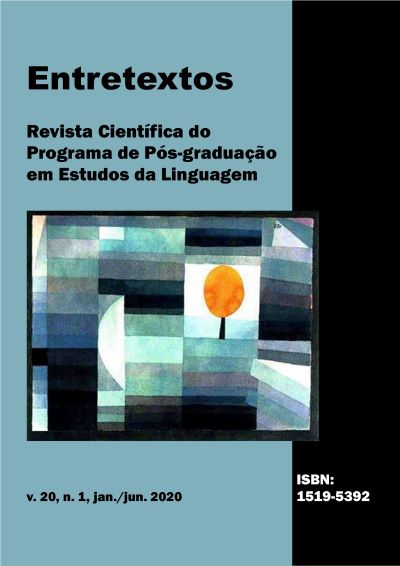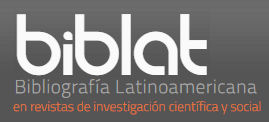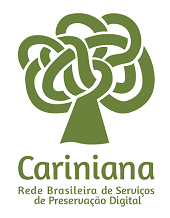A long history of social exclusion: the discursive representation of poverty in the news of São Paulo printed jornalismo
DOI:
https://doi.org/10.5433/1519-5392.2020v20n1p113Keywords:
Critical Discourse Analysis, Newspaper, Discourse Change, Social ExclusionAbstract
Related to the theory and methodology of Critical Discourse Analysis area (CDA), the goal of this research is to analyze and describe the newspapers published by paulista press in the course of XIX, XX and XXI ages about particular socially marginalized groups - in this research characterized as poor social segments due to low acess or exclusion from the job market- and that find themselves in a socio-economic, policy and cultural subordination related to other majority and dominant group. The objective of this analysis is to present a proposal capable of filling a gap that is not systematically fulfilled in the ACD, related to the fact that the "discursive change in relation to social and cultural change" (FAIRCLOUGH, 2001a, p.126) and the first concern of Critical Discourse Analysis "(FAIRCLOUGH, 2001b, p.28), and paradoxically, through a closer analysis of the available bibliography, the absolute primacy of research centered on the axis of synchrony is verified. Considering that the media regularly has been in the hands of dominants groups, we find in these newspapers a prejudiced discourse which agrees with the prevailing ideology. This kind of discourse can be structured in many ways of writing (contemporaneously camouflaged, as opposed to previous periods) aiming to the maintenance of a consensual hegemony and status quo. The analysis was based on data collected from Correio Paulistano and Folha de S. Paulo, being selected from historic newspapers clippings which were dealing with academic research goals.Downloads
References
BOLSAS PARA BAIXA RENDA EXTRAPOLARAM O ORÇAMENTO. Folha de S. Paulo, São Paulo, 15 mai. 2016, p. A 27.
COMUNICADOS: o Echo da verdade. O Correio Paulistano, São Paulo, 13 jul. de 1854. p. 2.
COSTA, Alessandra. Tradições Discursivas em jornais paulistas de 1854 a 1901: Gêneros entre a história da língua e a história dos textos. Munich: Grin, 2010.
COUTO, Berenice. O Direito Social e a Assistência Social na Sociedade Brasileira: uma equação possível? São Paulo: Cortez, 2006.
EXÉRCITO DA SALVAÇÃO ANGARIA FUNDOS COM “PANELAS DE NATAL”. Folha de S. Paulo, São Paulo, 9 dez. 1965. p. 11.
FAIRCLOUGH, Norman. Critical Discourse Analysis: the critical study of language. London and New York: Longman, 1995.
______. Discurso e mudança social. Brasília: Editora da Universidade de Brasília, 2001a.
______. Critical discourse analysis as a method in social scientific research. In: Wodak, Ruth e Meyer, Michael. (orgs.) Methods of critical discourse analysis. London, Thousand Oaks, Nova Delhi: Sage, 2001b. p. 121-138.
______. Analysing Discourse: textual analysis for social research. London: Routledge, 2003.
FREIRE FILHO, João. A sociedade do espetáculo revisitada. Famecos, Porto Alegre, nº 22, p. 33-46, 2003.
HALLIDAY, Michael. An Introduction to functional grammar. London: Edward Arnold, 1985.
MARSHALL, Leandro. O jornalismo na era da publicidade. São Paulo: Summus, 2003.
MARTIN, James; WHITE, Peter. The language of evaluation: appraisal in English. New York/Hampshire: Palgrave Macmillan, 2005.
NOTÍCIAS DAS PROVÍNCIAS. O Correio Paulistano, São Paulo, 3 ago. 1855. p. 2.
NOTÍCIAS DAS PROVÍNCIAS. O Correio Paulistano, São Paulo, 6 abr. 1855. p. 2.
OLIVEIRA, Francisco. Vanguarda do atraso e atraso da vanguarda: Globalização e neoliberalismo na América Latina. Revista Praga, São Paulo, n. 4, p. 31-33, 1997.
PERELMAN, Chaim; OLBRECHTS-TYTECA, Lucie. O tratado da argumentação: a nova retórica. São Paulo: Martins Fontes, 1996.
SODRÉ, Nelson. História da imprensa no Brasil. Rio de Janeiro: Mauad, 1999.
SPOSATI, Aldaíza. A menina LOAS: um processo de construção da assistência social. São Paulo: Cortez, 2007.
THOMPSON, John. Ideologia e cultura moderna: teoria social crítica na era dos meios de comunicação de massa. Petrópolis: Vozes, 1995.
______. Mídia e modernidade: uma teoria social da mídia. Petrópolis: Vozes, 2008.
VAN DIJK, Teun Adrianus. Discurso, poder y cognición social. Cuadernos, Cali, año 2, 1994. Disponível em
<www.discursos.org/Art/Discurso,%20poder%20y%20cognici%F3n%20social.pdf>. Acesso em: 6 de junho de 2018.
______. Discurso e poder. São Paulo: Contexto, 2008.
WODAK, Ruth. 2004. Do que trata a ACD: um resumo de sua história, conceitos importantes e seus desenvolvimentos. Linguagem em (dis)curso, Tubarão, v. 4, n. especial, p. 223-243, 2004.
Downloads
Published
How to Cite
Issue
Section
License
Entretextos adota a Licença Creative Commons Attribution 4.0 International, portanto, os direitos autorais relativos aos artigos publicados são do/s autor/es.
Sob essa licença é possível: Compartilhar - copiar e redistribuir o material em qualquer suporte ou formato. Adaptar - remixar, transformar, e criar a partir do material, atribuindo o devido crédito e prover um link para a licença e indicar se mudanças foram feitas.






















